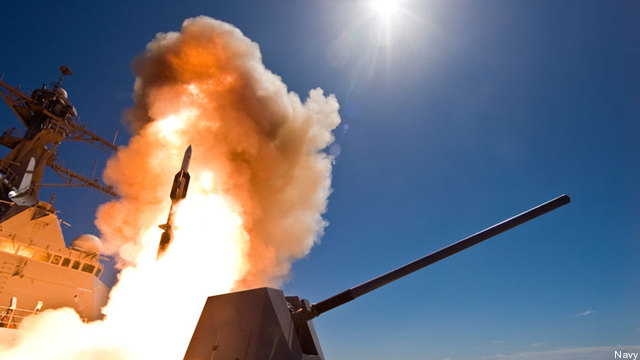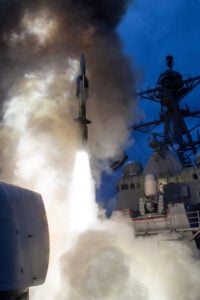You Spot, I Shoot: Aegis Ships Share Data To Destroy Cruise Missiles
Posted on

Imagine you’re a sniper. Imagine the bad guys are coming — but you can’t see them yet. Imagine your spotter can see them — but only because he’s miles away from where you are, with a better view. Now imagine that when you put your eye to your gunsights, you see the view through his. You fire. You hit the target. It goes down.
Replace the sniper and spotter in this scenario with a pair of 9,000-ton warships, replace the bad guys with incoming anti-ship cruise missiles, and replace your sniper rifle with a Raytheon SM-6 Standard Missile: Now you’ve got what actually happened in a recent Navy test whose results were announced today. For the first time, one Navy ship shot down a simulated cruise missile — two of them in a row, actually — that its own radars couldn’t see, relying entirely on data relayed from another vessel. (In this case, the shooter was the Aegis cruiser Chancellorsville, the spotter was the Aegis destroyer Sampson).
That “cooperative engagement capability” is crucial to the Navy’s vision of a future fleet that acts as a single network, each part sharing the data gathered by the whole. This is a concept that then-thinktanker Robert Work — later Deputy Secretary of the Navy and now Deputy Secretary of Defense — promulgated in 2008 as the Total Force Battle Network. It’s the bedrock of the program called NIFC-CA (Naval Integrated Fire Control-Counter Air), which will link Navy ships, fighters, and E-2D Hawkeye radar planes into a single network. Instead of each ship or plane only being able to fire on threats it can see with its own sensors — which may be at the last minute or even too late, given how low and fast some cruise missiles move — the fleet as a whole can engage incoming enemies as soon as anyone sees them. That lets you stop the threat as far away as possible and gives you the best chance of surviving against a Chinese-style “anti-access/area denial” system.

The USS John Paul Jones test-fires an SM-6 in June
“If you’ve got a number of ships that are now networked and communicating across a wide range of water,” said Raytheon’s program director for the Standard Missile-6, Mike Campisi, “and several of them have SM-6s, they can now communicate… and say ok, who has the best firing solution here? Who’s going to fire? How are we going to do that?”
One caveat: In this test, the mock cruise missile did show on the shooter ship’s radar at the very end of its flight, Campisi explained to me this afternoon. But the entire engagement, from launch to kill, relied entirely on data from the spotter ship, Sampson. “At the end when the shooting ship [Chancellorsville] could actually see the target, it wasn’t providing any data to the missile at that point,” Campisi told me. “The [SM-6] missile was on its own,” he said, making its final approach in a fully active self-guiding mode. The target flashed on the Chancellorsville‘s screen for a fraction of a second: “We’re talking hundredths of a millisecond,” he said. “‘I see it — oh it’s gone.'”
Raytheon SM-6 missiles have done such “engage on remote” test firings before, including one last year using the Army’s JLENS radar blimp. But in the previous tests, the spotter was always airborne, rather than a surface ship as was the case for the first time in this test. A flying spotter enjoys a much wider field of view than a spotter down on the surface, a major tactical advantage, but converting data from an airborne radar to a shipboard one is a technical challenge.
Because this test involved two Aegis radar/fire control systems talking to each other, Campisi said, it was actually easier than previous ones involving two different systems. “We’re always worried,” he told me, “[but] after looking at all of the data, it ended up being far more mundane than we thought.”
Subscribe to our newsletter
Promotions, new products and sales. Directly to your inbox.
